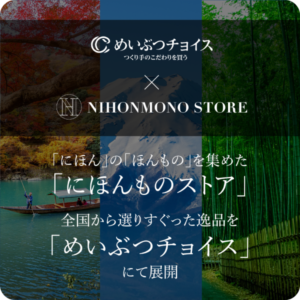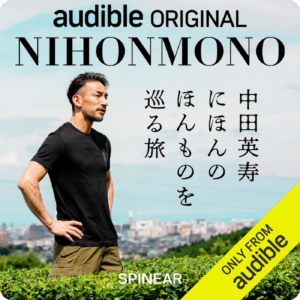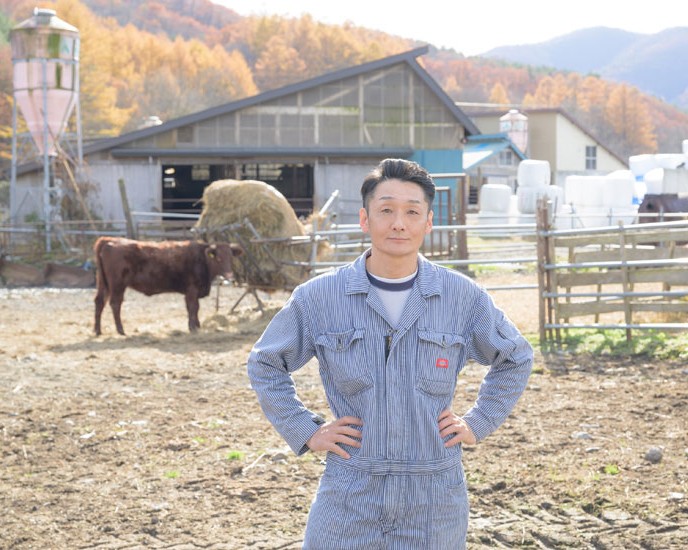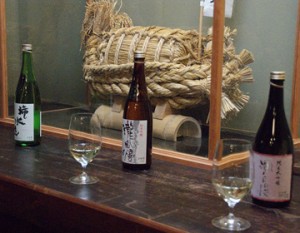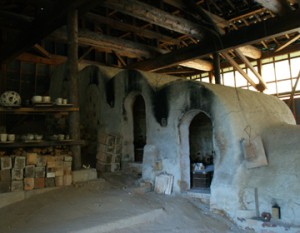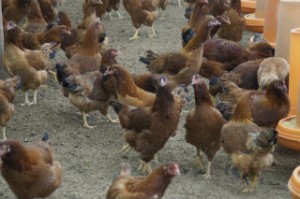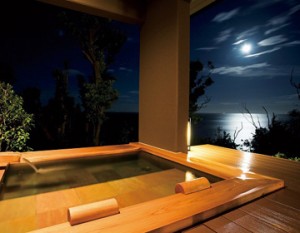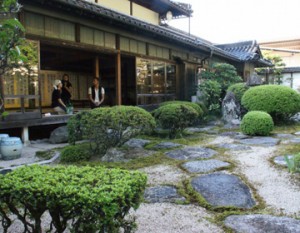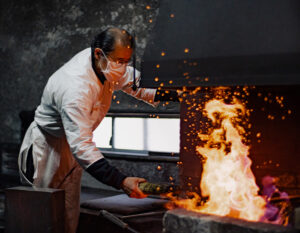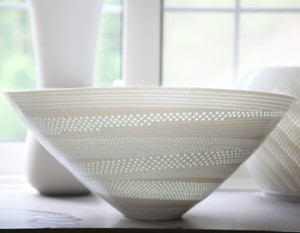In Japan, many Japanese black cattle (Wagyu) are raised exclusively for their meat, but in the northern part of Iwate Prefecture, the “Iwate Shorthorn Beef,” a Japanese Shorthorn breed, is widely bred. Kakinoki Chikusan, which raises and produces Iwate Shorthorn Beef in Yamagata-cho, Kuji City, is passionate about pursuing the taste and communicating its appeal.
History and Characteristics of Iwate Shorthorn Beef

In the past, the former Nanbu domain territory, including Iwate, raised native Nanbu cattle for farming, transportation, and to secure organic fertilizers. Nanbu cattle, which are strong on their feet and legs and can tolerate a poor diet, were also valued for their ability to graze in mountainous areas and the fact that they did not require much time and effort to raise. Especially in the northern part of Iwate Prefecture, where there was little flat land and summers were cool, the crop yields were unstable, so many farmers raised cattle for “marketing” in times of emergency.
Grazing from spring to fall, mating and calving in the wild

However, as time went by, the role of Nanbu beef began to decline. In an effort to improve the Nanbu beef breed into a beef breed, the Iwate Shorthorn Beef was born by crossing American Shorthorns and other breeds. The Shorthorn breed was chosen because it was large and suitable for pasturage, as was the case with the Nanbu Beef, because it needed to be large in size to increase its value as a beef cattle breed, and because the breed was to be raised on pasture, which was less labor-intensive than raising Nanbu Beef.
One of the characteristics of Shorthorn cattle is their “summer mountain and winter home” style of rearing, in which they are pastured in the mountains from spring to fall and raised in barns during the winter. The farmers who originally raised Nanbu cattle in this area also cultivated fields and wanted to concentrate on their work from spring to fall, so they grazed their cattle near their homes and fields. Even if they raised a large number of Shorthorn cattle, they still wanted to concentrate on other agricultural work, so they would graze their cattle in the mountains where there was more grass during the summer and take them down from the mountains in the winter when the grass would be dry. Of course, this rearing style is also good for the cows: calves born around March are grazed on the plateau with their mothers from spring to fall, where they can grow up on pesticide-free grass and mother’s milk. In the pastureland, the mother cow becomes pregnant through natural mating with her sire, and gives birth in the barn around March. This natural mating and natural delivery is another characteristic of Shorthorn cattle.
On the other hand, calves that move from pastureland to the barn are raised on feed and other means to “build up” their bodies in preparation for shipment. The feed varies from farmer to farmer and production area to production area. This changes the taste and other characteristics of the meat, so it is a good opportunity for the producers to show their skills.
Since Shorthorn cattle are born once a year, farmers set the shipping period as “22 to 30 months” so that they can be shipped throughout the year. Although there are differences in meat quality depending on the age of the cattle, in general, the meat is lean with low fat content and high amino acid content. This is why the meat is highly regarded by restaurant chefs and people accustomed to eating beef, who say they never get tired of eating it and can enjoy its flavor the more they chew it.
Domestic feed and pasture-raised cattle are used to create a “taste that can only be found here.

Toshiyuki Kakiki is the second generation of Kakiki Chikusan, a shorthorn cattle producer in Yamagata-cho, Kuji City in northern Iwate Prefecture. After graduating from high school, he entered Iwate Prefectural Agricultural College with the intention of taking over the family business. There, he learned for the first time about methods of raising cattle other than Shorthorn cattle and rediscovered the appeal of Shorthorn cattle, which are raised in a healthy manner through pasturage and natural mating and delivery.
Domestic feed is safe, tasty, and environmentally friendly

For more than 30 years since then, Mr. Kakiki has devoted himself to raising and producing “Shorthorn cattle only. He has also made every effort to raise his cattle in a healthier manner, for example, by setting up a space near the barn where calves can exercise freely, and grazing some of his mothers on a low mountain in late autumn.
The “heart” of Mr. Kakiki’s breeding and production methods is 100% domestically produced feed. Initially, he switched from imported feed to domestic feed in order to avoid post-harvest pesticides, which are used on imported agricultural products to prevent pests and diseases during transportation and storage. In addition, the feed is much less susceptible to exchange rate fluctuations than imported feed, and since it does not require energy for transportation, it also reduces carbon dioxide emissions. Mr. Kakiki began researching the possibility of using domestic feed. As a result, he now uses his own compound feed made from fusuma (wheat hulls), wheat, and soybeans, as well as domestically produced whole soybeans, hay, locally produced feed rice, and home-grown feed corn.
Kakinoki says, “Our meat has a long, lingering lean flavor, no odor, and clean fat. For example, the “clean fat” is created by feeding not only the kernels but also the leaves and stalks of home-grown feed corn.
Of course, “grazing” before feeding is also an important part of the meat quality, as the cattle are first fed grass to strengthen their stomachs and internal organs and create a base for lean meat. Incidentally, Kakinoki Chikusan’s main grazing land is on a plateau at an altitude of 700 m, and its grass is rich in minerals due to the northeasterly “Yamase” wind from the sea. Mr. Kakinoki’s Shorthorn Beef has a “taste that can only come from here,” thanks to the land and climate of Yamagata Town, as well as the grass and feed.
Communicating “serious efforts” from breeding to sales

Mr. Kakiki currently raises 110 head of cattle for breeding and 70 head of cattle for fattening annually. While most cattle farms are divided into breeding and fattening farms, he explains that the reason he is involved in both is “to ensure that I can get calves, as they are becoming harder to come by. In addition, they produce additive-free processed products such as hamburgers and cured hams, sell them wholesale to restaurants, and sell them directly on their e-commerce site. They are proud to be “involved in all aspects of Shorthorn Beef.
Selling only to contractors who understand our production methods

Still, there are many challenges that we face as Shorthorn cattle farmers. The biggest challenge is the low unit price of Shorthorn cattle meat. Although Shorthorn cattle account for less than 0.5% of Japan’s beef cattle, they are not well known, and the price is about half that of Wagyu beef. In addition, the fact that calving occurs only once a year makes it difficult for farmers to manage their cattle, and many farmers are switching to raising Kuroge Wagyu together or to raising Kuroge Wagyu.
In such an environment, Mr. Kakiki raises only Shorthorn cattle because he wants to convey to his clients and consumers that he is “serious about what he is doing. In fact, Kakinoki Chikusan’s sales partners outside of its e-commerce site are restaurants and major food delivery service companies that understand and sympathize with Kakinoki’s production methods and ideas, and who have signed contracts with him to provide safety-conscious foods.
Creating Fans of Kakinoki Livestock and Iwate Shorthorn Beef

Mr. Kakiki is also involved in his own “Community Support Agriculture (CSA). This is a system in which consumers continuously support producers by paying for their produce in advance and participating in farm work. Mr. Kakiki has created a membership fee-based community called “Shorthorn Beef Lover’s Club,” which ships products to member consumers, and also conducts farm tours and barbecue meetings in Tokyo to communicate the appeal of Shorthorn Beef and interact with consumers.
Mr. Kakiki believes that these activities will lead to the creation of fans not only of Kakiki Chikusan but also of Iwate Shorthorn Beef itself. Above all, by having people visit the ranch, they will be able to experience the splendor of Iwate’s terroir. Iwate has the largest land area in Honshu, and most of the inland area is hilly and mountainous, making it rich in nature and suitable for grazing. The mountains of Iwate are a comfortable place for cattle, which are sensitive to heat and resistant to cold, to be kept cool in summer, and Shorthorn cattle raised in a style that makes the most of this natural environment can be called Iwate culture. For Mr. Kakiki, on the other hand, shorthorn cattle have been a familiar animal since he was a child, and they are a special part of his family’s life. That is why the sight of the cows enjoying their time in the open pastures was and still is a treasure to him. Mr. Kakiki’s efforts to preserve his beloved Shorthorn cattle and their grazing landscapes continue.
